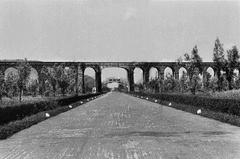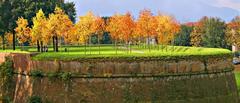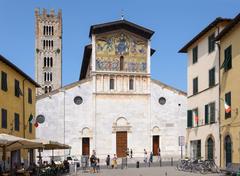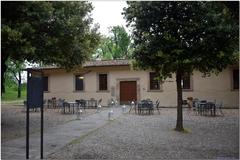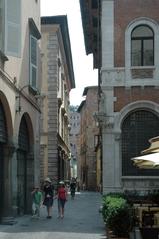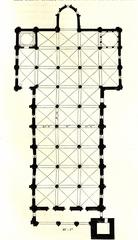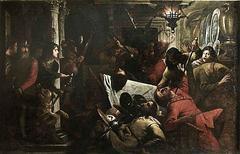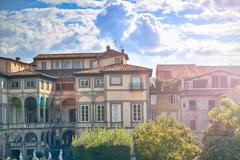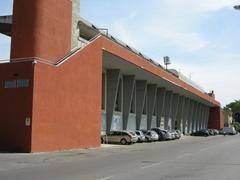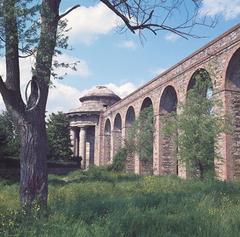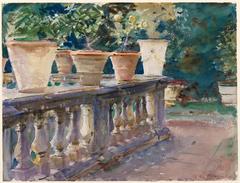Must Museum Of The City Of Lucca Urban Memory History Territory
Museum Of The City Of Lucca Visiting Guide: Tickets, Hours, and History
Date: 14/06/2025
Introduction
Nestled in the heart of Tuscany, Lucca is a city defined by its unique blend of ancient origins, remarkable Renaissance city walls, and vibrant cultural life. For visitors seeking to unlock the story of Lucca’s urban development and enduring heritage, the Must – Museum Of The City Of Lucca – Urban Memory History Territory is an essential stop. Located within the historic center, the Must Museum offers a compelling journey through the city’s evolution, featuring archaeological artifacts, interactive displays, and immersive multimedia exhibits that bring Lucca’s past and present to life.
This detailed guide covers everything you need to plan your visit: the museum’s history, mission, key exhibitions, practical visitor information, accessibility, ticketing, and tips for making the most of your time in Lucca. Whether you’re a history enthusiast, a family traveler, or a cultural explorer, the Must Museum provides a window into the city’s rich urban memory and community identity.
For up-to-date information on opening hours and ticket options, refer to the Lucca Musei Nazionali website and the Turismo Lucca portal.
Table of Contents
- Roman Foundations and Early Development
- Medieval Transformation and Autonomy
- Must Museum: Genesis, Mission, and Core Objectives
- Museum Layout and Key Exhibitions
- Visitor Information: Hours, Tickets, and Accessibility
- Guided Tours and Special Events
- Combining Your Visit with Other Historical Sites
- Practical Recommendations and Travel Tips
- Frequently Asked Questions (FAQ)
- Conclusion and Call to Action
Roman Foundations and Early Development
Lucca’s origins can be traced to pre-Roman settlements, with archaeological signs of Ligurian and possible Etruscan inhabitants. Becoming a Roman colony in 180 BCE, the city’s name is thought to derive from the Celtic-Ligurian “Luk,” meaning swamp, a nod to the area’s original landscape (alucca.com). Strategically situated along the Via Cassia and the Via Francigena, Lucca flourished as a key stop for pilgrims and merchants.
Today, visitors can still perceive the Roman grid layout in the city’s center and explore the Piazza dell’Anfiteatro, built atop the remains of a Roman amphitheater. Lucca’s historical significance is further highlighted by the 56 BCE meeting of Julius Caesar, Pompey, and Crassus, which reaffirmed the First Triumvirate.
Medieval Transformation and Autonomy
Following the fall of the Western Roman Empire, Lucca was governed by the Lombards, who established it as a duchy. By the 11th and 12th centuries, Lucca had grown into a self-governing commune, divided into five districts with a General Council (alucca.com). This era saw the expansion of the city’s political and economic influence, setting the stage for its Renaissance prosperity.
Must Museum: Genesis, Mission, and Core Objectives
Genesis and Historical Context
The preservation of Lucca’s urban landscape and memory inspired the establishment of the Must Museum. Recognizing the city’s layered history—from its Roman castrum origins through medieval independence and Renaissance grandeur—local planners, architects, and cultural experts advocated for an institution dedicated to safeguarding and interpreting Lucca’s unique territorial identity (planum.net). Founded by the Municipality of Lucca, the Must Museum is situated in a restored building within the ancient city walls and functions as a cultural hub for locals and visitors alike (luccamuseinazionali.it).
Mission and Objectives
- Preservation and Interpretation: The museum curates archival materials, maps, photographs, and artifacts spanning Lucca’s Roman, medieval, and modern eras.
- Education and Engagement: Through interactive exhibits, workshops, and guided tours, Must fosters public understanding of urban development and heritage conservation (turismo.lucca.it).
- Research and Documentation: Collaborations with universities and heritage organizations support ongoing research, accessible archives, and regular conferences (planum.net).
- Promotion of Cultural Tourism: Must partners with other local institutions, offering integrated itineraries and joint ticketing to enhance visitor experiences (luccamuseinazionali.it).
Museum Layout and Key Exhibitions
Architectural Setting
The Must Museum occupies a restored historic building in Lucca’s UNESCO-candidate old town, harmonizing original features like exposed brickwork and vaulted ceilings with modern exhibition spaces (Italia.it). The museum’s design ensures accessibility and intuitive visitor flow.
Floor Plan Overview
- Ground Floor: Entry, ticketing, and an introductory gallery with maps and a city model (FlorenceTips).
- First Floor: Permanent exhibitions tracing Lucca’s evolution from Roman times to the Renaissance.
- Second Floor: Temporary exhibitions and educational workshops.
- Basement: Archaeological displays and immersive installations.
- Amenities: Café, bookshop, accessible restrooms, and auditorium.
Permanent Collection: Urban Memory and Identity
The Walls of Lucca
A central highlight, this gallery features scale models, interactive displays on engineering and defense, and multimedia installations detailing the history and transformation of Lucca’s celebrated Renaissance walls (Italia.it).
From Roman Forum to Modern City
Artifacts, digital reconstructions, and thematic panels illustrate Lucca’s development from its Roman roots to the present, including transformations of key urban spaces like Piazza San Michele (FlorenceTips).
Urban Memory: Stories of the People
Through audio testimonials, photographic archives, and community art projects, this gallery documents Lucca’s social history and the lived experiences of its residents.
Temporary and Rotating Exhibitions
The museum’s upper floor hosts exhibitions on themes ranging from Italian post-war design to numismatics and popular culture, broadening engagement with both local and international audiences (Eventi Turismo Lucca).
Immersive and Educational Installations
- Archaeological Experience: Hands-on simulated digs and AR stations for interactive learning.
- Urban Planning Gallery: Interactive maps and a digital forum for public input on Lucca’s future.
Special Features
A meticulously crafted city model is updated annually, and original charters and city plans are displayed. Multilingual materials and audio guides are available.
Visitor Information: Hours, Tickets, and Accessibility
- Opening Hours: Tuesday to Sunday, 10:00 AM – 6:00 PM (last admission 5:30 PM). Closed Mondays (except public holidays). Confirm current hours on the official website.
- Tickets: Standard €8, reduced €5 (students, seniors, EU citizens 18–25), free for children under 18 and Lucca residents. Combination tickets for city museums are available (WhichMuseum).
- Accessibility: Fully accessible with ramps, elevators, tactile models, and multilingual guides.
- Guided Tours: Offered daily in Italian and English. Advance booking recommended, especially during peak seasons (Lucca Events).
- COVID-19 Protocols: Mask-wearing and hand sanitizer stations in line with local regulations.
Combining Your Visit with Other Historical Sites
Located within the pedestrian-friendly city center, the Must Museum is a short walk from:
- Piazza San Michele: Site of the Roman forum and Church of San Michele in Foro.
- Cathedral of San Martino: Renowned for its art and architecture (museiprovincialucca.it).
- Torre Guinigi: Famous for its rooftop garden and panoramic views.
- Orto Botanico Comunale di Lucca: A serene botanical garden founded in 1820 (Trips on Abbey Road).
Practical Recommendations and Travel Tips
- Best Times to Visit: Spring (April–June) and autumn (September–October) offer pleasant weather and fewer crowds (Savoring Italy).
- Getting There: The museum is a 10–15 minute walk from the main railway station; parking is available just outside the city walls (Nomads Travel Guide).
- Dress Comfortably: Wear sturdy shoes for walking on cobblestones; dress in layers.
- Photography: Non-flash photography is permitted in most areas.
- Amenities: Restrooms, cloakrooms, and a gift shop are available; cafés abound nearby.
Frequently Asked Questions (FAQ)
Q: What are the Must Museum Lucca visiting hours?
A: Tuesday to Sunday, 10:00 AM – 6:00 PM; closed Mondays. Always check the official website for seasonal variations.
Q: How do I purchase tickets?
A: Tickets are available online or at the entrance. Advance booking is encouraged during busy periods.
Q: Is the museum accessible?
A: Yes, the facility is fully accessible for visitors with mobility challenges.
Q: Are guided tours available?
A: Yes, in multiple languages; reserve in advance for groups or during peak times.
Q: Can I take photos inside?
A: Photography is allowed in most galleries without flash or tripods.
Conclusion and Call to Action
The Must – Museum Of The City Of Lucca is a gateway to understanding the city’s complex urban narrative, blending historical preservation with modern interpretation. Its accessible location, engaging exhibitions, and comprehensive visitor services make it a highlight of any Lucca itinerary. Combine your museum visit with explorations of nearby historical landmarks to experience the full spectrum of Lucca’s heritage.
For the most current information on exhibitions, events, and visiting details, consult the Lucca Musei Nazionali website and the Turismo Lucca portal. Enhance your visit with the Audiala app, offering interactive guides and audio tours, and follow us on social media for news and cultural updates.
Visuals:
- Panoramic image of the Must Museum’s exterior (alt: “Exterior of the Must Museum in Lucca’s historic center”)
- Visitors interacting with multimedia exhibits (alt: “Visitors engaging with interactive displays at Must Museum Lucca”)
- Map showing museum location and nearby attractions (alt: “Map highlighting Must Museum Lucca and nearby historical sites”)
Internal links:
References
- Exploring Lucca: A Visitor’s Guide to Historical Sites, Monuments, and Practical Tips, 2024, (alucca.com), (museiprovincialucca.it), (thetouristchecklist.com)
- Must Museum Lucca: Visiting Hours, Tickets, and Exploring Lucca’s Historical Sites, 2024, (turismo.lucca.it), (planum.net), (luccamuseinazionali.it), (Eventi Turismo Lucca)
- Visiting the Must Museum Lucca: Hours, Tickets, and Highlights of Lucca’s Historical Sites, 2024, (Italia.it), (FlorenceTips), (WhichMuseum), (Lucca Events)
- Visiting the Must Museum Lucca: Hours, Tickets & Top Tips for an Unforgettable Experience, 2024, (Nomads Travel Guide), (Trips on Abbey Road), (Fondazione Paolo Cresci), (Turismo Lucca)
